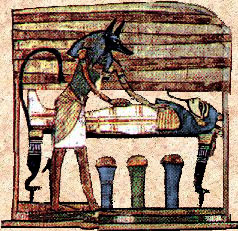
THE BOOK OF THE DEAD
The Book of the Dead is a name usually given to a collection of funerary texts from various dates, which contained magical formulas, hymns and prayers believed by the ancient Egyptians to guide and protect the soul (KA) in its journey into the region of the dead (Amenti).

Egyptians believed that the knowledge of these texts enabled the soul to ward off demons attempting to impede its progress, and to pass the tests set by the 42 judges in the hall of Osiris (god of the underworld). These texts also indicated that happiness in the afterlife was dependent on the deceased's having led a virtuous life on earth. The earliest funerary texts known were found cut in hieroglyphs on the walls inside the pyramids of the kings of 5th and 6th Dynasties of the Old Kingdom; these became known as the Pyramid texts. A famous example is found in the pyramid of Unas (who reigned between 2428-2407), the last king of the 5th Dynasty.
In the first Intermediate period and in the Middle Kingdom private individuals had these texts painted on coffins, from which the alternate name Coffin Texts is derived. By the 18th Dynasty the texts were inscribed on papyri placed in the mummy case. These papyri were frequently from 15 to 30m (50 to 100ft) long and illustrated in colour. This vast collection of mortuary text has survived through several dynasties of power in Ancient Egypt.